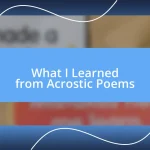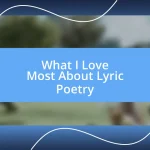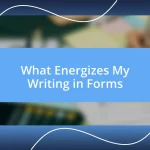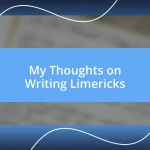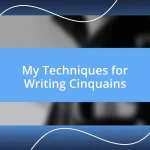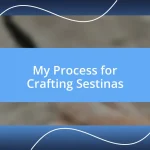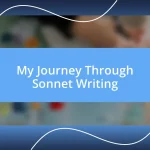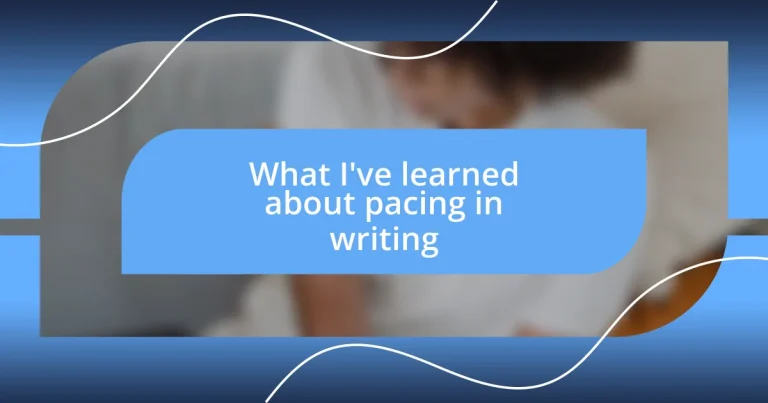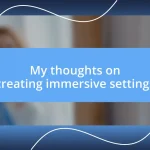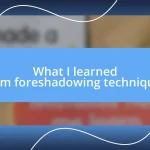Key takeaways:
- Pacing is essential in writing, influencing how readers engage with the narrative through the use of fast and slow rhythms to evoke urgency or reflection.
- Effective techniques for controlling pacing include varying sentence lengths, managing dialogue speed, and intertwining action with exposition to maintain reader interest.
- Revising for pacing improvement involves stepping back, reading aloud, incorporating feedback, and experimenting with exercises like rewriting scenes and creating pacing maps.
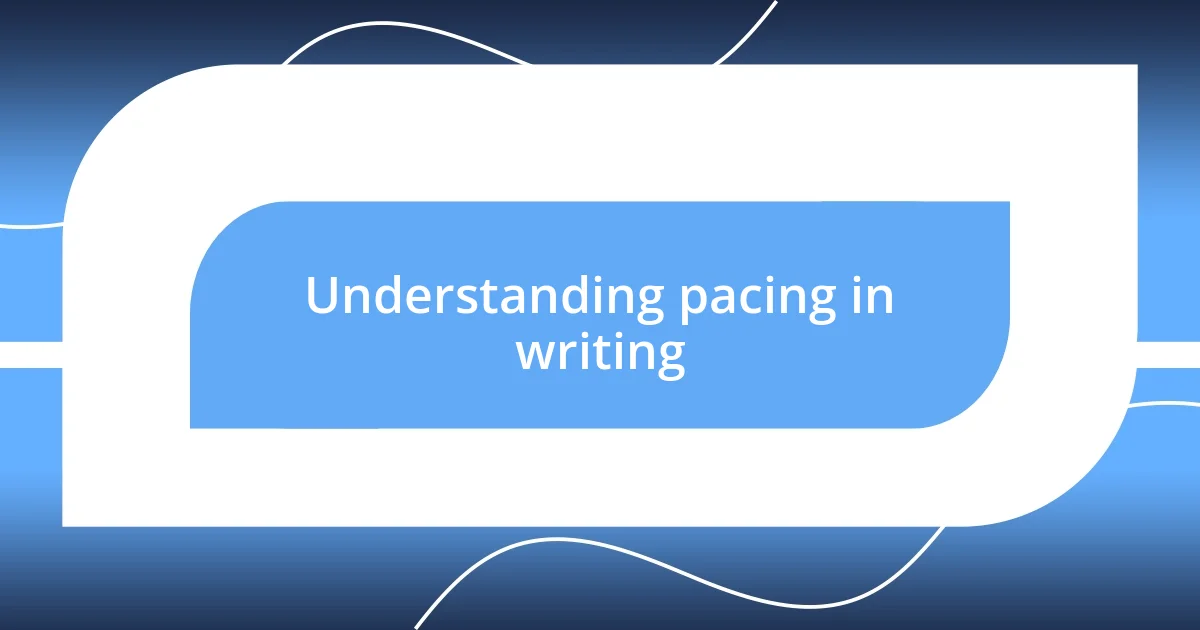
Understanding pacing in writing
Pacing in writing is all about the rhythm and flow of your narrative. In my experience, when I write a scene filled with action, I tend to shorten my sentences. This not only quickens the pace but also allows the readers to feel the adrenaline. Have you ever noticed how a quickened pace can mirror the urgency of a moment? It’s like the heart racing during an intense movie scene, pulling you deeper into the experience.
Conversely, slower pacing can create a sense of reflection and intimacy. I remember crafting a poignant moment in a story where a character was processing loss. By extending the sentences, layering emotional details, and allowing pauses, I invited my readers to share that heavy moment with her. Wouldn’t we all want to savor the depth of such experiences? Slowing down can enrich our connection with the narrative, making us linger on each word.
Understanding pacing also involves being aware of your audience’s engagement. There have been times when I felt the urge to speed things up, only to realize that the build-up is just as critical to the payoff. It’s a dance between tension and release; if done right, it can keep readers on the edge of their seats, eager to turn the page. How do you find the balance in your writing? For me, experimenting with pacing has been a transformative part of honing my craft.
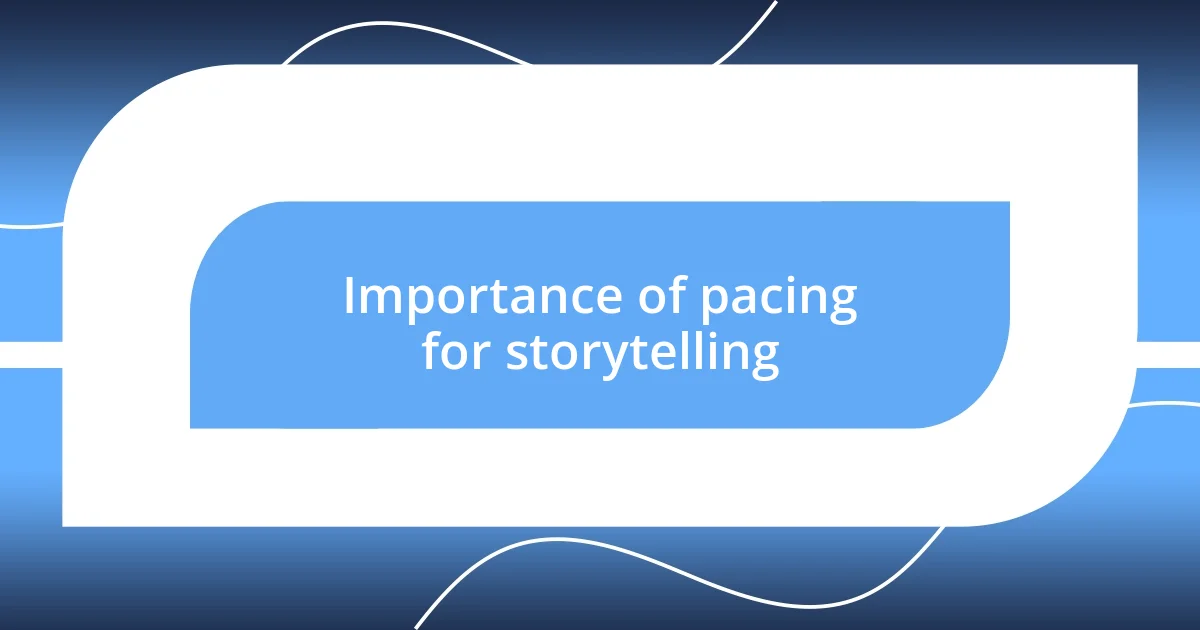
Importance of pacing for storytelling
Pacing is crucial for storytelling because it shapes how readers engage with the story. I once wrote a scene where time seemed to stretch endlessly, emphasizing a character’s dread before a big decision. I remember intentionally dragging out the dialogue to immerse readers in the tension. The result? My audience was practically holding their breath, unable to look away, which reminded me of how powerful a well-timed pause can be.
Moreover, balancing fast and slow pacing creates a dynamic rhythm that captures and retains interest. I’ve realized that a thrilling chase should never be followed immediately by a slow reflection; it’s essential to maintain a contrast. For example, I once interspersed fast-paced action with brief moments of silence, allowing readers to catch their breath. This ebb and flow not only mirrored the emotional highs and lows but also kept readers craving the next twist in the narrative.
Lastly, pacing offers an opportunity to mirror a character’s emotional journey. When a character experiences joy, quickening the tempo can amplify that excitement. However, I learned the hard way that if you rush through sorrowful moments, you risk losing the visceral impact of the story. Reflecting on my earlier work, I now understand the importance of allowing those moments of heartache to unfold naturally, inviting readers to fully experience the emotional depth alongside the characters.
| Pacing Type | Impact on Story |
|---|---|
| Fast Pacing | Creates urgency and excitement; keeps readers on edge. |
| Slow Pacing | Invites reflection and emotional depth, enhancing character connection. |
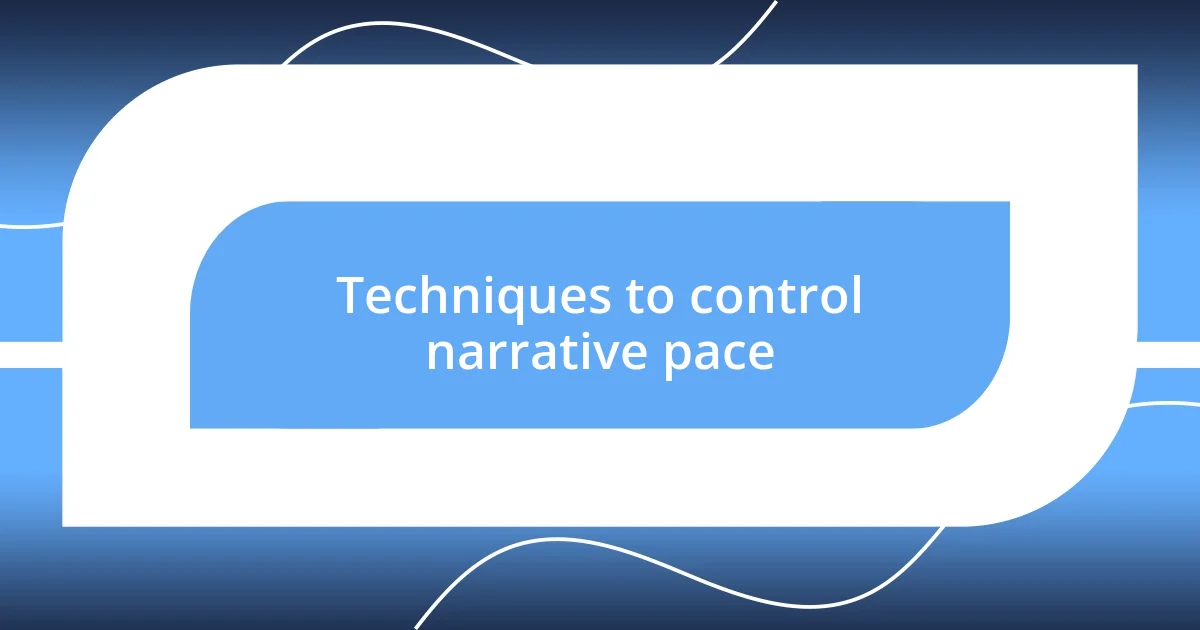
Techniques to control narrative pace
Controlling narrative pace is like playing an instrument — each technique offers a different tone and effect. I often use varied sentence lengths to affect pacing naturally. Short, snappy sentences pull readers into the action, while longer, descriptive sentences allow them to savor the moment. I remember a scene where I alternated between these lengths during a climactic reveal; it created a push-and-pull that left my readers breathless one moment and contemplative the next.
Here are some techniques I find effective for managing narrative pace:
- Vary Sentence Length: Short sentences for action, longer for introspection.
- Control Dialogue Speed: Quick exchanges can indicate urgency, while drawn-out conversations build tension.
- Scene Breaks: Introducing scene breaks can create a pause, allowing readers to digest important moments.
- Descriptive Passages: Using vivid imagery in slower parts can encourage reflection.
- Internal Monologue: When characters reflect, it slows the pace, giving readers insight into their thoughts and feelings.
Each technique serves a purpose, and I’ve learned that the right choice not only enhances the pace but deepens the reader’s experience, drawing them closer to the story and its characters.
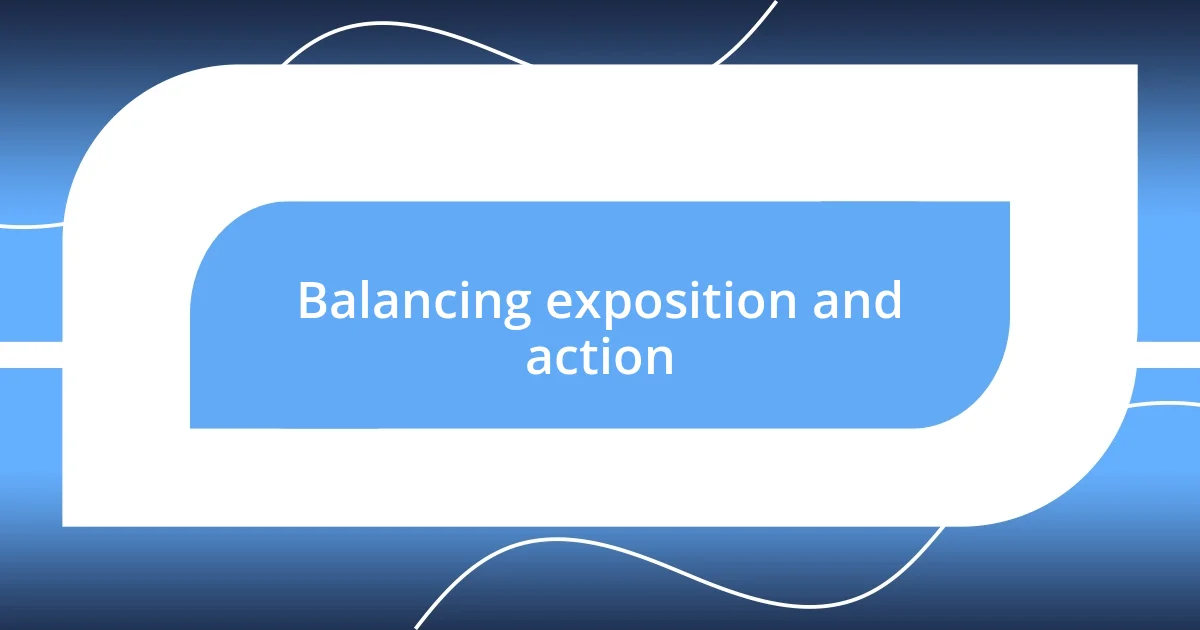
Balancing exposition and action
Finding the right balance between exposition and action can often feel like walking a tightrope. There have been times when I’ve spent pages diving into the backstory of a character, only to realize that readers were itching for a little more movement. I remember crafting a chapter where I delved deep into a character’s past, and while it offered valuable context, it slowed the momentum painfully. Reflecting on that moment, I learned that it’s crucial to break up exposition with action to maintain engagement; otherwise, the story can feel stagnant.
I’ve experimented with layering action over exposition, and I found that it works beautifully in certain scenarios. For instance, in a recent story, I had a character narrating her thoughts about a pivotal choice while simultaneously racing to escape danger. This mix allowed me to convey vital information while keeping the adrenaline pumping. Ask yourself: how can your characters’ actions serve as a vehicle for their backstories? By entwining action with exposition, I’ve realized you can create a more immersive experience, drawing readers into the narrative’s heart.
Ultimately, pacing isn’t just about the speed; it’s about the rhythm of the story. I often think about the moments that touch me as a reader — those where I feel both the weight of the past and the rush of the present. Balancing exposition with action is about crafting a dance; sometimes, the exposition needs to lead, while other times, the action takes the spotlight. It’s this dynamic interplay that keeps readers not just invested, but truly connected to the journey unfolding before them.
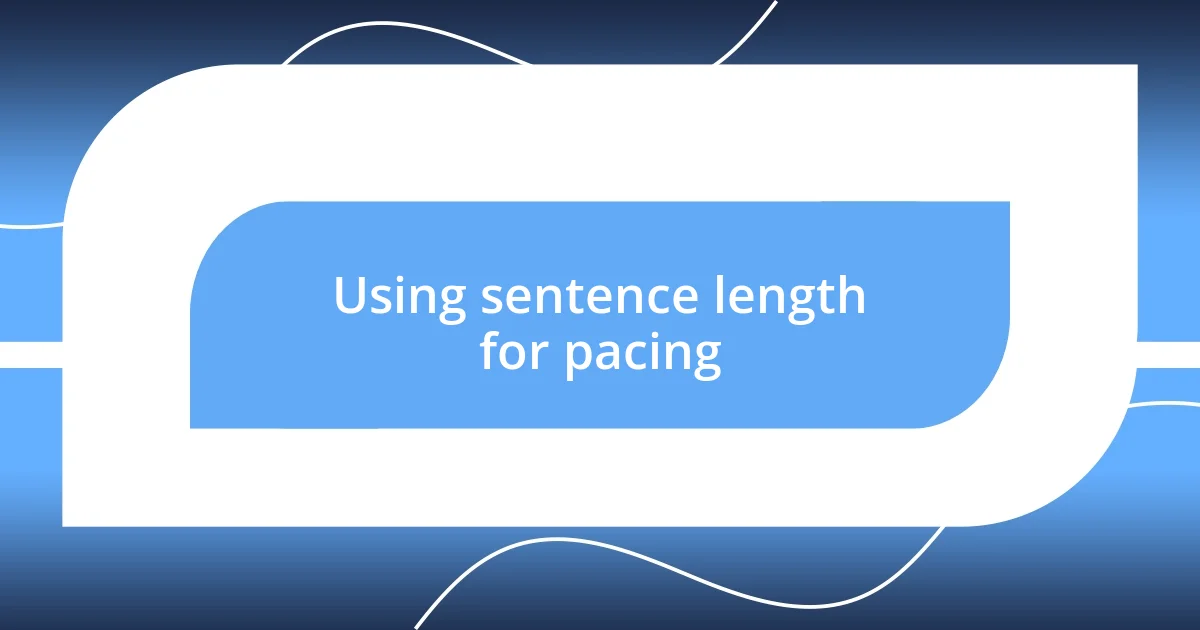
Using sentence length for pacing
Using sentence length effectively is crucial in shaping the pacing of your writing. Whenever I want to pick up the pace, I gravitate toward short, punchy sentences. For example, during a heart-pounding chase scene, I found that quick bursts of dialogue and action kept my readers on the edge of their seats – they had no choice but to race along with the characters. It’s fascinating how just a few well-placed short sentences can transform the urgency of a moment.
On the flip side, I embrace longer sentences when I want readers to pause and absorb emotions or visual details. I remember crafting a poignant scene where a character reflects on a lost relationship. By weaving together more elaborate descriptions, I allowed readers to feel the weight of nostalgia, letting the words linger like a sigh in the air. How often do we rush through our thoughts when sometimes, we should let them breathe? Giving them that space can deepen the reader’s connection to the characters and their experiences.
Of course, blending both short and long sentences is where the magic happens. Picture this: a moment of frantic action, followed by a character’s momentary reflection. This shift not only creates a rhythm but also gives readers a chance to catch their breath before the next burst of excitement. I’ve discovered that the contrast between sentence lengths can mirror life’s own ebbs and flows. How do you want your readers to feel? By playing with pacing through sentence length, you can guide them through an emotional journey in a way that’s both compelling and memorable.
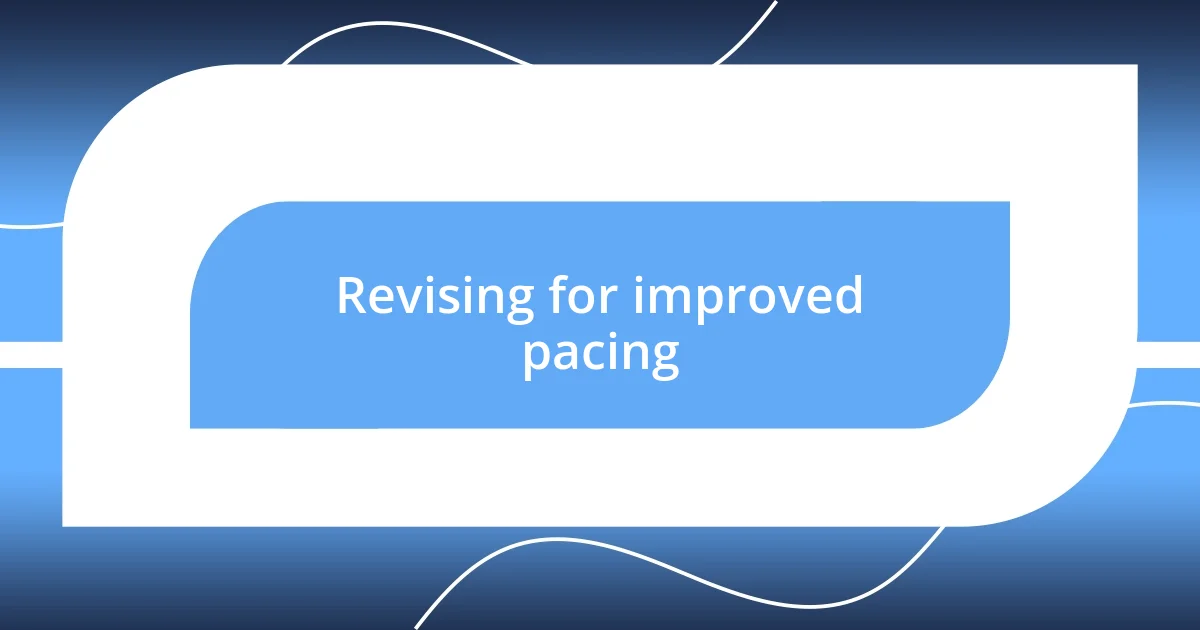
Revising for improved pacing
Revising for improved pacing is often an enlightening experience for me. I’ve found that stepping away from a draft and returning with fresh eyes makes a significant difference. For instance, during one of my revisions, I noticed a scene dragging on longer than necessary. I thought, “Does this really serve my narrative?” So, I cut several paragraphs and replaced them with sharp, engaging dialogue. The result? A tight, dynamic scene that energized the story.
Another tactic I’ve employed is reading my work aloud, which has transformed how I approach pacing. I remember revising a chapter while listening to it flow through my own voice. It became evident where I stumbled—those areas were too dense or meandering. By adjusting the rhythm through careful cuts and adding breaks, I created an easier reading experience. Isn’t it amazing how hearing your words shift the perception of pacing?
Lastly, incorporating feedback from other readers has been invaluable. When a fellow writer pointed out that one section felt sluggish, it ignited a spark of realization. I learned to scrutinize those slower sections more critically, revising them not just for content but also for energy. Reflecting on this process, I now ask myself, “Does this part propel the story forward?” This question guides my revisions, ensuring each moment resonates with the ebb and flow of the narrative’s pace. It’s an agile dance between reader engagement and storytelling that evolves with each revision.
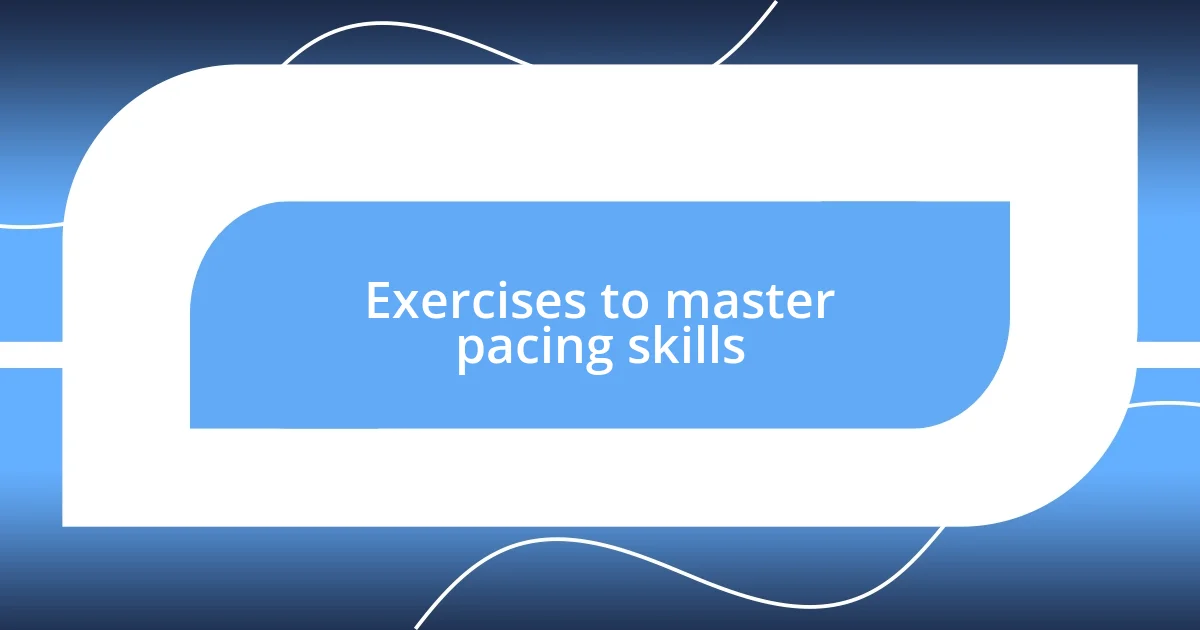
Exercises to master pacing skills
Engaging in specific pacing exercises can be a game-changer for your writing. One exercise I swear by is the “two drafts” method. First, I write a scene at a slow pace, rich in detail and emotion. Then, I take the same scene and rewrite it using the shortest sentences possible, focusing solely on action. It’s enlightening to see how shifting gears can reveal different layers of a moment. Have you ever tried rewriting a passage in two distinctly different ways? It’s like discovering hidden treasures in your own work.
Another useful exercise is creating “pacing maps.” I take a piece of my writing, highlighting sections where I want to speed up or slow down. This visual representation helps me map out the emotional highs and lows. I remember doing this with a short story I wrote, and it felt as if I was rearranging a music composition. Each highlight told me, “This needs to build,” or “Here, let’s linger.” Do you think you can feel the rhythm just by looking at the colors on the page? It’s a fun way to visualize your narrative’s flow.
Lastly, experimenting with pacing through dialogue offers excellent results. I often write a conversation between characters specifically designed to create tension. By shortening the responses and breaking the dialogue with interruptions, I can heighten the pace to match the urgency of their emotions. I once penned a heated argument where the back-and-forth felt like a rapid-fire exchange, and the impact was electric. Can you remember a time when dialogue made your heart race? When you harness the pacing in dialogue, you not only propel the story but also draw readers deeper into the emotional conflict.
